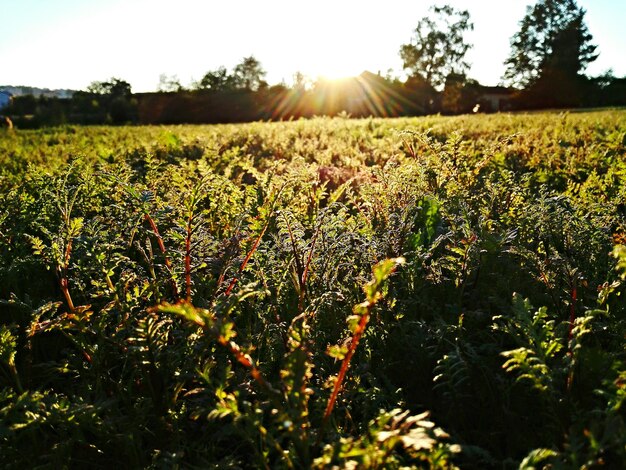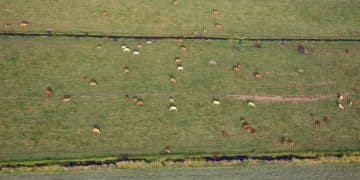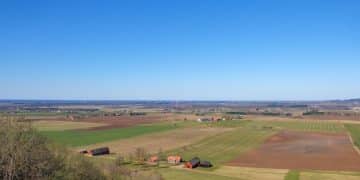Regenerative Agriculture: Your Step-by-Step Guide to Soil Health

Regenerative agriculture is a farming and land management approach that focuses on rebuilding soil health, enhancing biodiversity, and improving water cycles, ultimately leading to more resilient and productive ecosystems and increased crop yields.
Are you ready to revolutionize your farming practices and create a healthier, more sustainable future? Regenerative agriculture: A Step-by-Step Guide to Improving Soil Health and Crop Yields offers a path to revitalize your land and boost your harvests.
Understanding Regenerative Agriculture
Regenerative agriculture represents a paradigm shift from conventional farming, prioritizing the long-term health of the soil and ecosystem. It’s about working with nature, not against it.
What is Regenerative Agriculture?
Regenerative agriculture is a conservation and rehabilitation approach to farming and food systems. It focuses on topsoil regeneration, increasing biodiversity, improving the water cycle, enhancing ecosystem services, supporting biosequestration, increasing resilience to climate change, and strengthening the health and vitality of farm soil.
Key Principles of Regenerative Agriculture
Several core principles guide regenerative agriculture, promoting practices that enhance the health and resilience of agricultural ecosystems.
- Minimize Soil Disturbance: Reducing tillage protects soil structure, prevents erosion, and preserves beneficial microbial life.
- Increase Soil Cover: Using cover crops and mulches helps suppress weeds, regulate soil temperature, and conserve moisture.
- Promote Biodiversity: Integrating diverse plant and animal species enhances ecosystem stability and resilience.
- Integrate Livestock: Managed grazing can improve soil fertility, stimulate plant growth, and enhance carbon sequestration.

By adopting these principles, farmers can create thriving agricultural systems that benefit both the environment and their bottom line. Prioritizing soil health and biodiversity enables greater resilience and productivity.
Step 1: Assessing Your Soil Health
Before implementing any regenerative practices, it’s crucial to understand the current state of your soil. Assessing soil health provides a baseline for measuring progress and tailoring strategies.
Conducting a Soil Test
A comprehensive soil test analyzes essential nutrients, pH levels, organic matter content, and potential contaminants. Use a reputable lab and follow their instructions carefully for accurate results.
Visual Soil Assessment
Observe your soil’s physical characteristics. Look for signs of compaction, erosion, or poor drainage. Healthy soil is dark, crumbly, and has a pleasant earthy smell.
Consider these visual indicators to help determine the steps you need to take to improve your current lands state.
- Color: Darker soil typically indicates higher organic matter content.
- Structure: Crumbly soil suggests good aggregation and water infiltration.
- Smell: A fresh, earthy scent indicates healthy microbial activity.
Understanding your soil’s baseline conditions is the crucial first step in your regenerative agriculture journey. Be sure to gather adequate samples.
Step 2: Reducing Soil Disturbance
Conventional tillage practices can disrupt soil structure, deplete organic matter, and release carbon into the atmosphere. Minimizing soil disturbance is a cornerstone of regenerative agriculture.
No-Till Farming
No-till farming involves planting crops directly into undisturbed soil, eliminating the need for plowing or harrowing. This practice conserves soil moisture, reduces erosion, and promotes beneficial microbial activity.
Benefits of Reducing Tillage
Reducing tillage offers numerous benefits for soil health and productivity. Reduced erosion, water conservation and increased organic matter are very beneficial.
Benefits include:
- Improved Soil Structure: Reduces compaction and enhances water infiltration.
- Increased Organic Matter: Preserves carbon and supports thriving microbial communities.
- Reduced Erosion: Protects topsoil from wind and water erosion.

By minimizing soil disturbance, farmers can create healthier, more resilient agricultural systems that require less external input. Implementing reduced tillage will result in greater gains in the long run.
Step 3: Implementing Cover Crops
Cover crops are plants grown primarily for the benefit of the soil rather than for harvest. They play a vital role in regenerative agriculture by improving soil health, suppressing weeds, and enhancing nutrient cycling.
Selecting the Right Cover Crops
Choose cover crops based on your specific goals and climate. Legumes like clover and vetch fix nitrogen in the soil, while grasses like rye and oats help suppress weeds and prevent erosion.
Benefits of Cover Crops
Cover crops offer a multitude of benefits for soil health and crop yields. They increase fertility, control weeds and reduce erosion.
- Improved Soil Fertility: Enhances nutrient availability and reduces the need for synthetic fertilizers.
- Weed Suppression: Outcompetes weeds and reduces the need for herbicides.
- Erosion Control: Protects soil from wind and water erosion.
Integrating cover crops into your farming system can significantly improve soil health, reduce input costs, and enhance overall productivity. Using the right cover crop can produce great results.
Step 4: Integrating Livestock
When managed properly, livestock integration can promote soil health, stimulate plant growth, and enhance carbon sequestration. Managed grazing practices mimic natural grazing patterns.
Rotational Grazing
Rotational grazing involves moving livestock to different paddocks or pastures on a regular basis. This allows plants to recover, prevents overgrazing, and promotes healthy root growth.
Benefits of Integrating Livestock
Livestock integration offers numerous benefits for land management and soil health. This holistic approach restores landscapes.
- Improved Soil Fertility: Livestock manure fertilizes the soil and enhances nutrient cycling.
- Stimulated Plant Growth: Grazing stimulates plant growth and promotes biodiversity.
- Reduced Weed Pressure: Livestock can graze on weeds and help control their spread.
Integrating livestock into your farming system can create a more balanced and resilient ecosystem. These steps can restore vitality to the land.
Step 5: Enhancing Biodiversity
A diverse ecosystem is a healthy ecosystem. Promoting biodiversity in your farming system can enhance resilience, improve pest control, and support beneficial insect populations.
Creating Habitat for Beneficial Insects
Planting native wildflowers and creating hedgerows can provide habitat for pollinators, predators, and other beneficial insects. These insects help control pests and support healthy plant growth.
Benefits of Enhancing Biodiversity
Enhancing biodiversity can improve productivity, reduce pest outbreaks and strengthen ecosystem resilience.
- Improved Pest Control: Beneficial insects help control pest populations, reducing the need for pesticides.
- Enhanced Pollination: Pollinators support crop production and improve yields.
- Increased Ecosystem Resilience: Diverse ecosystems are more resistant to climate change and other disturbances.
By promoting biodiversity, farmers can create more resilient and productive agricultural systems that benefit both the environment and their bottom line. Take action now!
| Key Point | Brief Description |
|---|---|
| 🌱 Soil Assessment | Determine your soil’s current health through testing and visual assessment. |
| 🚜 Reduced Tillage | Minimize soil disturbance to improve structure and conserve organic matter. |
| 🌾 Cover Crops | Use cover crops to enhance soil fertility and control erosion. |
| 🐄 Livestock Integration | Integrate livestock with managed grazing to improve fertility and plant growth. |
FAQ
▼
The primary goal is to improve soil health, increase biodiversity, and enhance the water cycle, leading to more sustainable and resilient farming systems.
▼
No-till farming helps to preserve soil structure, reduce erosion, and increase organic matter content, which supports microbial life.
▼
Common choices include legumes like clover and vetch for nitrogen fixation, and grasses like rye and oats for weed suppression and erosion control.
▼
Rotational grazing prevents overgrazing, allows plants to recover, and promotes healthy root growth, while livestock manure fertilizes the soil.
▼
Biodiversity enhances ecosystem resilience, improves pest control by supporting beneficial insects, and supports healthy plant growth through improved pollination.
Conclusion
Regenerative agriculture offers a promising path towards a more sustainable and resilient future for farming. By implementing these step-by-step and considering different options, farmers can create healthier and more productive ecosystems, ensuring long-term viability.





